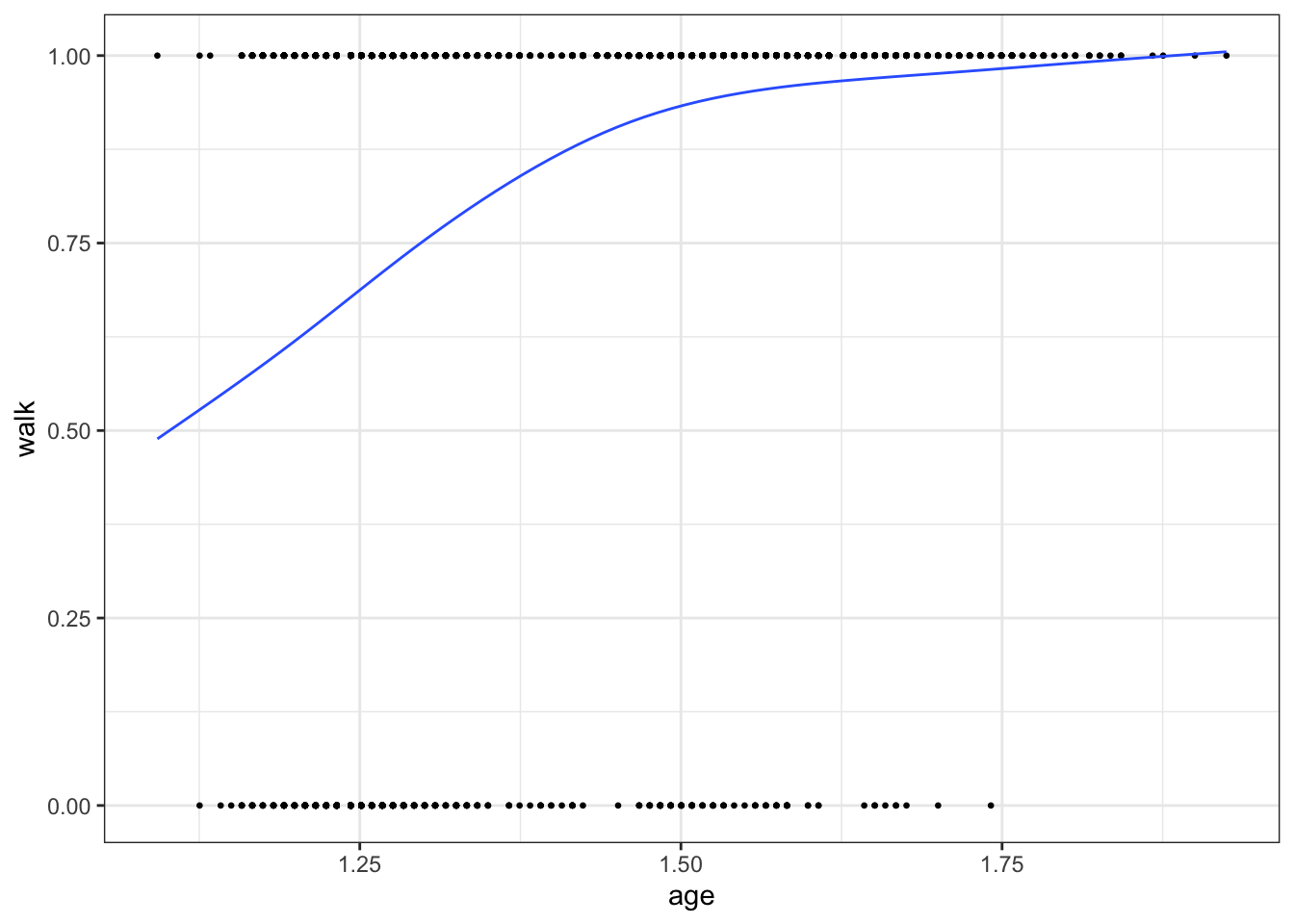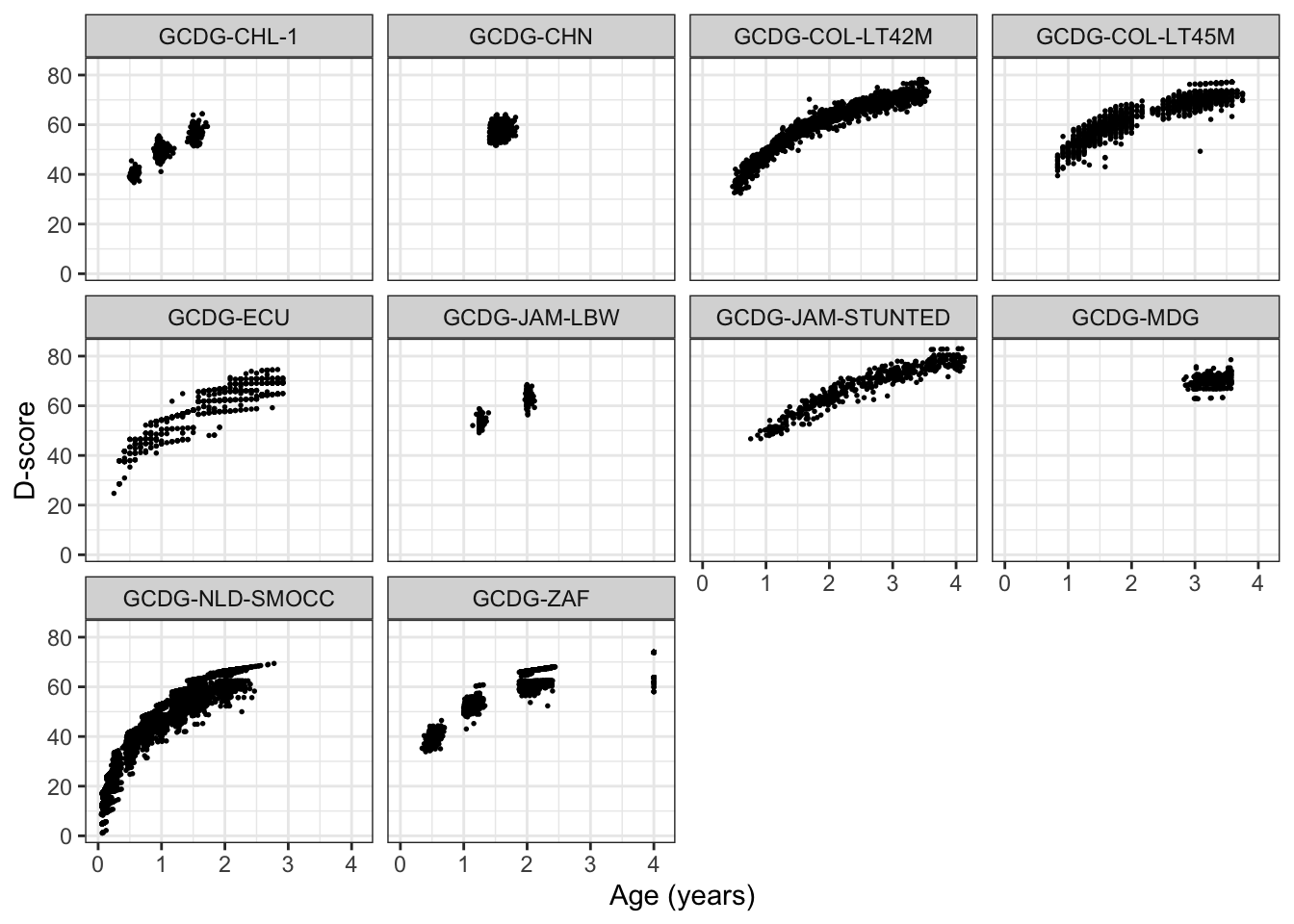
The goal of childdevdata is to support innovation in
child development. The package
The current version bundles milestone data from ten studies, containing 1,116,061 assessments made on 10,831 unique children during 28,465 visits, covering 21 different instruments.
You can install the development version of childdevdata
from GitHub with
install.packages("remotes")
remotes::install_github(repo = "d-score/childdevdata")The following example visualises how the proportion of toddlers that are able to walk increases with age.
library(childdevdata)
library(ggplot2)
# we use the Dutch SMOCC data
data <- with(gcdg_nld_smocc,
data.frame(age = round(agedays/365.25, 4),
walk = ddigmd068))
ggplot(na.omit(data), aes(age, walk)) +
geom_point(cex = 0.5) +
geom_smooth(method = "gam", formula = y ~ s(x, bs = "cs"),
se = FALSE, lwd = 0.5) +
theme_bw()
The package contains multiple datasets. Obtain the list of datasets by
data(package = "childdevdata")$results[, "Item"]
#> [1] "gcdg_chl_1" "gcdg_chn" "gcdg_col_lt42m" "gcdg_col_lt45m"
#> [5] "gcdg_ecu" "gcdg_jam_lbw" "gcdg_jam_stunted" "gcdg_mdg"
#> [9] "gcdg_nld_smocc" "gcdg_zaf"The documentation of the data can be found by typing into the console:
?gcdg_col_lt42mThe size of the data is
dim(gcdg_col_lt42m)
#> [1] 1311 627The first six rows and first nine columns are
head(gcdg_col_lt42m[, 1:9])
#> # A tibble: 6 x 9
#> ctrycd cohort cohortn subjid agedays sex gagebrth aqicmc010 aqicmc013
#> <chr> <chr> <int> <int> <int> <chr> <int> <int> <int>
#> 1 COL GCDG-COL-LT… 50 5000001 660 Fema… 224 NA NA
#> 2 COL GCDG-COL-LT… 50 5000002 1166 Fema… 280 NA NA
#> 3 COL GCDG-COL-LT… 50 5000003 314 Fema… 273 NA NA
#> 4 COL GCDG-COL-LT… 50 5000004 1239 Fema… 259 NA NA
#> 5 COL GCDG-COL-LT… 50 5000005 679 Fema… 224 NA NA
#> 6 COL GCDG-COL-LT… 50 5000006 1074 Fema… 252 NA NAThe first seven columns are administrative and background variables. Column numbers eight and up hold the milestone scores.
Concatenating two or more data is straightforward using
dplyr. The following code concatenates all avialable GCDG
datasets.
library(dplyr)
#>
#> Attaching package: 'dplyr'
#> The following objects are masked from 'package:stats':
#>
#> filter, lag
#> The following objects are masked from 'package:base':
#>
#> intersect, setdiff, setequal, union
alldata <- bind_rows(gcdg_chl_1, gcdg_chn, gcdg_col_lt42m, gcdg_col_lt45m, gcdg_ecu, gcdg_jam_lbw, gcdg_jam_stunted, gcdg_mdg, gcdg_nld_smocc, gcdg_zaf)
dim(alldata)
#> [1] 28465 1306Both the number of rows and the number of columns have increased.
Milestones not appearing in a particular data obtain all missing
(NA) scores.
The number of records per cohort by sex is
table(alldata$cohort, alldata$sex)
#>
#> Female Male
#> GCDG-CHL-1 970 1169
#> GCDG-CHN 509 481
#> GCDG-COL-LT42M 646 665
#> GCDG-COL-LT45M 651 684
#> GCDG-ECU 337 330
#> GCDG-JAM-LBW 242 201
#> GCDG-JAM-STUNTED 207 270
#> GCDG-MDG 113 92
#> GCDG-NLD-SMOCC 8499 8223
#> GCDG-ZAF 2154 2018The dscore
package calculates the D-score (van Buuren 2014) and the D-score
adjusted for age Z-score (DAZ) for all cases:
library(dscore)
alldata$age <- round(alldata$agedays/365.25, 4)
d <- dscore(alldata)
head(d)
#> a n p d sem daz
#> 1 1.024 29 0.690 50.4 0.666 0.286
#> 2 1.509 22 0.955 57.8 1.445 0.269
#> 3 0.975 29 0.724 50.8 0.682 0.742
#> 4 1.016 29 0.759 51.3 0.700 0.649
#> 5 1.016 22 0.682 49.1 0.677 -0.099
#> 6 1.517 25 0.840 56.9 1.058 -0.070
dim(d)
#> [1] 28465 6We visualise the D-score distribution by age per cohort as
alldata <- bind_cols(alldata, d)
ggplot(alldata, aes(age, d, group = cohort)) +
geom_point(cex = 0.3) +
facet_wrap(~ cohort) +
ylab("D-score") + xlab("Age (years)") +
theme_bw()
#> Warning: Removed 380 rows containing missing values (geom_point).
We all want our children to grow and prosper. While there is no
shortage of apps and instruments to track child development, it is often
unclear which data went into the construction of these tools. In order
to improve measurement and norm setting of child development, we need
child-level response data per milestone and age. However, no such public
dataset seem to exist. The childdevdata package fills that
void.
The package grew out of a project in which we collected milestone data from 16 cohorts. See Weber et al. (2019) and http://d-score.org/dbook2/ for results. Ten cohort owners graciously decided to make their data available for third parties. We are grateful to them.
Tremendous effort has gone into the collection and harmonisation of the data. You can use the data in this package under the CC BY 4.0 license. Basically, this means that you may share and adapt the data, on the condition that you give appropriate credit and clearly indicate any changes you’ve made. See the license text for details.
We expect that you will properly cite the source data when you use the data in your own product or publication, as follows:
childdevdata package.The citation of the childevdata data package is
@dataset{stef_van_buuren_2021_4685945,
author = {Stef van Buuren and
Iris Eekhout and
Marta Rubio Codina and
Orazio Attanasio and
Costas Meghir and
Emla Fitzsimons and
Sally Grantham-McGregor and
Maria Caridad Araujo and
Susan Walker and
Susan Chang and
Christine Powell and
Ann Weber and
Lia Fernald and
Paul Verkerk and
Linda Richter and
Betsy Lozoff},
title = {D-score/childdevdata: childdevdata 1.0.0},
month = apr,
year = 2021,
publisher = {Zenodo},
version = {v1.0.0},
doi = {10.5281/zenodo.4685945},
url = {https://doi.org/10.5281/zenodo.4685945}
}Do you have similar data and want to help others to advance the
field? Please let us know. We hope that the childdevdata
package may continue to grow into a valuable resource for developers and
researchers worldwide.